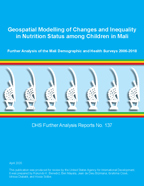- PUBLICATIONS
- JOURNAL ARTICLES
- ACCESS PUBLICATIONS
Publications Summary
- Document Type
- Further Analysis
- Publication Topic(s)
- Geographic Information, Nutrition, Wealth/Socioeconomics
- Country(s)
- Mali
- Survey
- Mali DHS, 2018
- Language
- English
- Recommended Citation
- Benedict, Rukundo K., Benjamin K. Mayala, Jean de Dieu Bizimana, Ibrahima Cisse, Idrissa Diabaté, Kissia Sidibe. 2019. Geospatial Modelling of Changes and Inequality in Nutrition Status among Children in Mali: Further Analysis of the Mali Demographic and Health Surveys 2006-2018. DHS Further Analysis Reports No. 137. Rockville, Maryland, USA: ICF.
- Download Citation
- RIS format / Text format / Endnote format
- Publication Date
- April 2020
- Publication ID
- FA137
Download
 Geospatial Modelling of Changes and Inequality in Nutrition Status among Children in Mali (PDF, 4076K)
Geospatial Modelling of Changes and Inequality in Nutrition Status among Children in Mali (PDF, 4076K)
Download this publication
There is no printed copy available to order.
